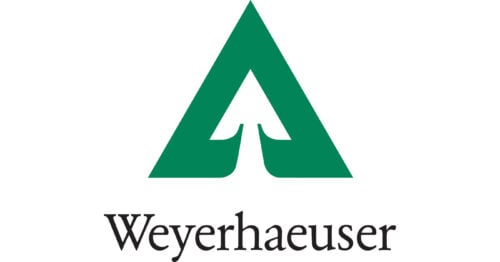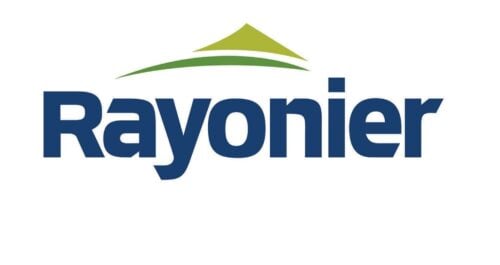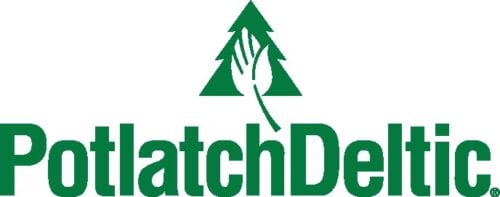Institutional investors are increasingly using timber REITs as a way to diversify client portfolios. Despite volatility in lumber prices, investing in timber REITs could continue to provide steady growth and a stable income. That said, let’s dive deep into the best publicly traded timber REITs to buy now.
Best Timber REITs
Weyerhaeuser Co (NYSE: WY)
Weyerhaeuser leads our list of the best publicly traded timberland REITS as the largest in its asset class. The timber REIT is a size leader in acreage and market capitalization.
It’s also a favorite for institutional investors, who own up to 84% of the REIT stocks.
The timber REIT owns and operates over 11 million acres of timberland primarily located in the West, South, and Northeast of the United States.
WY is also responsible for managing timberland in Canada, which expands its portfolio by an additional 14 million acres.

The timber REIT currently boasts a whopping $25 billion market cap, which equals approximately $1 billion in valuation per operated acre.
But Weyerhaeuser doesn’t only focus on selling timber. The timber REIT makes the most out of its land by diversifying it into multiple income opportunities.
Recreation, conservation, economic development, and renewable energy are among how WY profits from its timberlands.
Aside from its land business, the timber REIT also operates 35 manufacturing facilities to produce other wood products.
Sustainability is deeply rooted within their identity as Weyerhaeuser Corporation operates in a continuous and fully sustainable cycle and sponsors several environmentally conscious initiatives.
As with other real estate investment trusts, REIT dividends are paid out to investors. Currently, Weyerhaeuser offers shareholders a 2.20% dividend yield.
The timber REIT price-to-earnings (P/E) ratio is a mere 10.69, a considerably fair valuation.
Weyerhaeuser Company reported Q3 2022 results recently, beating estimates with an EPS beat of 12.47%. However, revenues decreased from the same period last year.
According to management, the quarter performance reflects softening demand and the work stoppage that commenced in mid-September.
Softening export demand is likely linked to the rising costs of the dollar and a global slowdown in the housing market.
Weyerhaeuser is in a particularly good position regarding its cash reserves, an advantage that could serve them well during a recession period. The REIT has cash on hands equivalents of nearly $2 billion dollars.
The WY share price has been on an uptrend channel since its IPO, with some minor exceptions.
The price has broken out of the channel twice, once during the 2008 recession and another time during the 2020 Covid-19 scare.
If the REIT continues this upward trend, shareholders could expect a steady investment increase.
Rayonier Inc (NYSE: RYN)
The second place on our list of publicly traded timber real estate investment trusts is reserved for one of the oldest, as Rayonier has been in the business for a remarkable 96 years.
With over 2.7 million acres of timberland ownership, RYN sustainably yields more than 11 million tons of timber yearly.
But the timber REIT focuses on more than just wood. Like Weyerhaeuser, Rayonier also engages in alternative investment opportunities to complement its income and maximize its timberland yield.
The REIT’s core businesses are split between real estate and forest resources. RYN employs asset and portfolio management real estate strategies while playing the long game on timberlands.

Rayonier makes the most out of every acre by diversifying its timberland business into recreation, minerals, energy, and wood products.
Although the company also engages in ancillary income and real estate, it remains one of the purest timberland REITs available. An estimated 73% of its income comes from selling timber.
This makes the timber REIT extremely vulnerable to market fluctuations in timber prices.
By market cap, RYN may be the smallest on the list, but at $5.2 billion, it’s a considerably large player in the REIT market.
What may come as a surprise for investors is the P/E ratio. At 64x, it could be considered overpriced by value investors; however, considering its long-term vision on timber, it’s possible the number could be reflecting future valuations.
Rayonier does offer investors a generous share of their profits, offering a dividend yield of 3.21% to the timber REIT holders.
The timber REIT employs a sustainable yield harvest model, balancing timber growth with near-term harvest cash flows.
RYN puts forward environmentally conscious investment opportunities. Its commitment to ESG transparency can be appreciated in its accreditation.
The REIT is certified by the Sustainable Forestry Initiative, a code of conduct for members of the American Forest & Paper Association.
Rayonier owns a great deal of its timberland in New Zealand, which has benefited the share price. The current timber deficit in China is driving demand for New Zealand wood, raising lumber prices.
The earnings report reflects driven demand and rising lumber prices. Rayonier beat expectations for Q3 2022, posting $0.15 cents per share — 50% above consensus.
However, investors should exercise caution and keep an eye on the Chinese timber deficit. A change in the status quo could affect lumber prices and consequently affect the price of this timber REIT.
Related: The 5 Best ESG REITs To Buy Now
Potlatchdeltic Corporation (NASDAQ: PCH)
PCH has recently increased in size while simultaneously taking control of 50% of the timberland REIT market.
Potlatchdeltic Corporation merged with one of its competitors CatchMark Timber Trust. Effectively reducing publicly traded timber REIT investment opportunities by one-fourth.
The joint venture further diversifies Potlatchdeltic into the Southern markets of the United States. CatchMark’s timberland ownership of 350,000 acres in Alabama, Georgia, and South Carolina is now under the management of Potlatchdeltic.
The merger extended the total timberland ownership of Potlatchdeltic to approximately 2.2 million acres in seven states.

PCH wood products include lumber and plywood, and US lumber prices have fallen over the past few months as the housing market cools off amid interest rates rise.
Lumber prices peaked at nearly $1,400 this year just to fall to their current level near $400.
As plywood and lumber are key building materials, the timberland REIT is susceptible to the housing market’s performance.
Despite market volatility, Potlatchdeltic’s diversified operations help the REIT generate stable cash flow.
Its ability to generate cash flow has supported a dividend yield payment which currently stands at 3.77%.
In the third quarter of 2022, Potlatchdeltic posted relatively good earnings, considering the lower lumber prices. The timberland REIT posted revenues of $306 million, up from the same time last year, which brought in $287 million.
Timberland’s Adjusted EBITDA also increased in Q3 by $6.6 million from Q2 2022.
The REIT has a post-merger market cap of $3.75 billion and an excellent P/E ratio of 8.83x.
Potlatchdeltic Corporation has been setting higher lows on the price chart since 2003, indicative of an uptrend. If continued, shareholders could see further share price appreciation over the long run.
Are Timber REITs a Good Investment?
Timber REITs could be a viable long-term investment for investors looking to benefit from rising lumber prices and timberland costs.
Institutional investors such as pension funds are increasingly using Timberland as a diversification asset class. It is no surprise as they offer attractive stability, income, and growth potential.
Additionally, there are several other factors that could influence timber producers’ profits in the short term.
There is a timber deficit in China and an increase in inflation, which contribute to the rise in lumber prices.
The European energy crisis is also under the radar and could catalyze higher demand. As energy prices soar, Europeans could take to their wood-burning stoves as an energy alternative.
The timberland industry is resilient; timber is unique in its class. Unlike most crops, wood can always be stored and sold later, minimizing losses during times of less economic activity.
Timber investments tend to outperform other assets, making them an institutional investor’s favorite for long-term investments. This could be because raw materials tend to always be in moderate to high demand.
Lumber prices fluctuate in the short term, but demand tends to grow steadily over the long term. In fact, the consumption of raw timber and processed wood products is expected to grow 37% by 2050.
Most of today’s commercial timber in the US is used for construction, but timber is also used in unexpected places. Power poles, textiles, tires, mulch, wood pallets, and paper all employ byproducts of wood in their production.
Unlike most REITs, publicly traded timberland REITs own and manage timberland on their own.
Real estate investment trusts offer other benefits to investors, such as passive income via a dividend yield.
There are also tax advantages involved when investing in real estate investment trusts. Qualifying real estate investment trusts profits don’t count as taxable income.
Other timber investment vehicles include timber ETFs; however, they might not be the best option for investors looking for a pure timber investment.
But timberland real estate investment trusts are just one of many timber investment opportunities. Timber ETFs are also available in the stock market.
Timber ETFs may diversify away from timber into other sectors, such as paper production. Diluting the ETF may affect performance.
Last year, timber REITs enjoyed significant gains due to increased housing demand. The NCREIF timberland index saw returns of 2.38% during Q3 2022 and had one of its best years in 2021.
Even if timber prices take a dive in the short term, there is the possibility that the industry will remain strong over the coming decades.
Institutional investors have greater resources at hand than retail investors, giving them an edge in the markets. Their affinity for timberland REITs is not one to take for granted, as it could provide clues into good investment opportunities.
Did you know about publicly traded timber REITs before reading this article?
Whether you previously did or not, now that you know more about publicly traded timber REITs, you might consider adding one (or more) to your portfolio.
You might also like:
These Are The 10 Best Residential And Apartment REITs To Buy For Income!
The 8 Best Mortgage REITs To Buy Right Now!
The 6 Best Farmland REITs To Buy Now


 Tags:
Tags:










